A new link has been discovered between microglia and anxiety. Image designed by Freepik.
The pressures of today have led to a chronic anxiety pandemic. An estimated 31.1% of adults in the U.S. will experience an anxiety disorder at some point in their lives. Anxiety disorders include generalised anxiety disorder, as well as phobia-related disorders, and obsessive-compulsive spectrum disorders.
Despite its high prevalence, the molecular mechanisms underpinning chronic anxiety are poorly understood. Nonetheless, a recent study from the University of Utah suggests that sub-populations of microglia regulate anxiety and obsessive-compulsive spectrum disorders. Microglia are the resident immune cells of the brain and make up 10% of the total cell mass in the brain. While the role of microglia is typically overlooked in favour of neurons, which represent the fundamental units of the brain, this new evidence offers a new potential therapeutic target. This could lead to better treatment for chronic anxiety disorders.
An estimated 31.1% of adults in the U.S. will experience an anxiety disorder at some point in their lives.
The research team observed that ablation of microglia expressing the gene Hoxb8 in mice results in both chronic anxiety and pathological grooming to an extent where it causes lesions at the sites of overgrooming. Pathological grooming is believed to be analogous to trichotillomania in humans, which refers to compulsive hair pulling. Evidence suggests Hoxb8 disruption may be involved in the pathogenesis of trichotillomania. Interestingly, the Hoxb8 gene is involved in the specification of the embryonic body plan yet disrupted Hoxb8 does not result in changes to the three-dimensional body pattern.
Next, the team optogentically activated the Hoxb8-expressing microglia in different areas of the brain. Optogenetics is a genetic technique allowing reversible activation of neuronal cells, such as neurons and microglia, using light. They found that optogenetic activation of Hoxb8 microglia in the dorsomedial striatum and the medial prefrontal cortex induced pathological overgrooming. Contrastingly, optogenetic activation of Hoxb8 microglia in the basolateral amygdala and the central amygdala induces anxiety. Furthermore, activation of Hoxb8 microglia in the CA1 area of the hippocampus induces both behaviours, as well as a freezing response, which is believed to demonstrate fear.
The researchers also investigated activation of the non-Hoxb8 microglia subpopulation in the same brain areas and found evidence of reduced anxiety. Moreover, simultaneous co-activation of both subpopulations of microglia cancelled out any behavioural changes. This suggests these two subpopulations work in opposition to each other, rather than in parallel.
The findings offer new hope for those afflicted with these disabling diseases.
This suggests Hoxb8 microglia function to downregulate anxiety and obsessive-compulsive behaviours, whole non-Hoxb8 microglia accelerate anxiety and obsessive-compulsive behaviours. It may seem paradoxical that both the optogenetic activation and the ablation of Hoxb8 microglia induced elevated levels of anxiety. This can be explained by describing the role of Hoxb8 microglia as inhibitory. If the normal role of this microglia subpopulation is to inhibit anxiety and grooming behaviour, the optogenetic activation acts to release this inhibition, thus leading to increased anxiety.
The combined findings of the role Hoxb8 and non-Hoxb8 microglia play in the up- and downregulation of anxiety and obsessive-compulsive spectrum disorders offer new hope for those afflicted with these disabling diseases. Further investigations are needed, but preliminary results indicate that medications targeting these microglia subpopulations in an attempt to downregulate pathological anxiety and obsessive-compulsive disorders could result in effective treatment and management.





